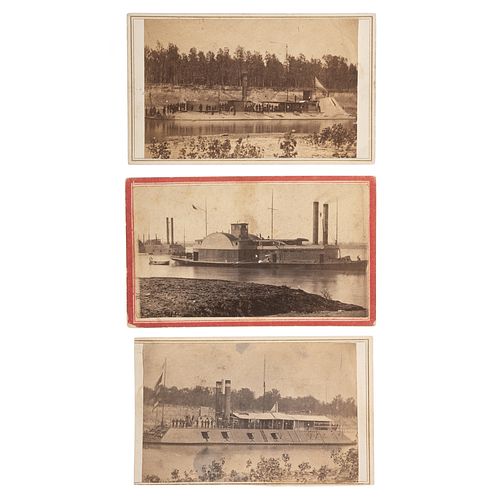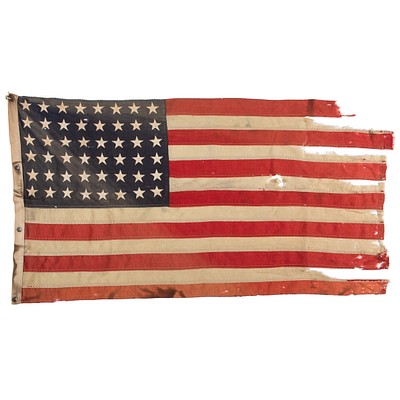Three Superb CDVs of Brown Water Navy Warships, Incl. USS Louisville, USS General Price, and USS Conestoga
About Seller
6270 Este Ave.
Cincinnati , OH 45232
United States
With offices in Cincinnati, Cleveland and Denver, Cowan’s holds over 40 auctions each year, with annual sales exceeding $16M. We reach buyers around the globe, and take pride in our reputation for integrity, customer service and great results. A full-service house, Cowan’s Auctions specializes in Am...Read more
Two ways to bid:
- Leave a max absentee bid and the platform will bid on your behalf up to your maximum bid during the live auction.
- Bid live during the auction and your bids will be submitted real-time to the auctioneer.
Bid Increments
| Price | Bid Increment |
|---|---|
| $0 | $25 |
| $500 | $50 |
| $1,000 | $100 |
| $2,000 | $250 |
| $5,000 | $500 |
| $10,000 | $1,000 |
| $20,000 | $2,500 |
| $50,000 | $5,000 |
| $100,000 | $10,000 |
About Auction
Jun 26, 2020
Cowan's Auctions is delighted to present the June 26 American Historical Ephemera and Photography Auction, including 55 lots devoted to the African American experience, over 175 lots dating from the Civil War Era, and more than 60 lots documenting life in the American West. Cowan's Auctions dawnie@cowans.com
- Lot Description
Three Superb CDVs of Brown Water Navy Warships, Incl. USS Louisville, USS General Price, and USS Conestoga
Lot of 3 CDVs. Carte of the US Gunboat Louisville. McPherson & Oliver: New Orleans, LA, n.d. A large number of the ship's company, some beneath protective canvas awnings amidships, can be seen loitering at the rails actually watching the photographer on shore. The starboard battery of four guns is run out as are the pair of stern chasers.
USS Louisville was a purpose built ironclad gunboat constructed at St. Louis and commissioned on January 16, 1862. Originally an army warship dictated by budgetary imperative, she was later transferred to Navy command in October 1862 and served as such for the duration. USS Louisville first joined in combined operations leading to the capture of Fort Donelson on February 16, 1862. In March she assisted in the occupation of Columbus, Kentucky and capture of Island No. 10 and New Madrid, Missouri through April 7. An established routine of vigorous patrolling prevented the small Confederate naval flotilla and vital transports from ascending the Mississippi while cutting off surreptitious cross river traffic. Louisville joined the Mississippi Flotilla for the attack on Memphis and shared in the laurels for sinking or capturing the entire Rebel naval force on June 6. Afterwards, Louisville bombarded the upper shore batteries of Vicksburg before shifting to the White River. Meeting with a large contingent of Mississippi Squadron warships, Louisville joined in a combined operation in support of W.T. Sherman's troops who captured the dominant feature of Fort Hindman at Arkansas Post, bagging nearly five thousand prisoners but getting no closer to the strategic prize of Vicksburg. In April 1863, USS Louisville and others ran the batteries at Vicksburg on the 16th and engaged in the bombardment of Confederate positions at Grand Gulf silencing those guns so that the siege ring was closed by April 29. From March to April 1864 Louisville and her sisters participated in the ill-fated expedition up the Red River, which resulted in Confederate General Richard Taylor succeeding in not only defending the Red River Valley with his smaller force but also forcing Banks to retreat after defeating a portion of the Union Army at the back-to-back battles of Mansfield and Pleasant Hill. On June 20 gunfire from Louisville was instrumental in breaking up a Confederate attack on an isolated Union brigade at a backwater called Gaines' Landing. The final year of Brown Water Navy endeavors focused on patrolling to interdict supplies to the Trans-Mississippi while rapidly transporting supplies and troops in lieu of a satisfactory railroad network. Louisville was finally decommissioned at Mound City on July 21, 1865.
CDV of the "US Steamer Gen. Price/off Baton Rouge/The USS Conestoga lying/astern/Jan. 20th 1864" as identified in period ink. A.D. Lytle: Baton Rouge, LA, n.d. General Price was originally a civilian sidewheel steamboat taken into Confederate service in 1861 as the CSS General Sterling Price. In May 1862 off Fort Pillow she and her sisters attacked vessels of the Mississippi Squadron in an action known as Plum Point Bend. During the fight the General Bragg and then the General Price concentrated on the Union gunboat Cincinnati which was rammed and heavily damaged by Price. She also managed to silence a nearby federal mortar boat but received extensive damage in exchange being "struck by a 128-pound shell which cut off her steam supply and caused a dangerous leak." She fought at the Battle of Memphis on June 6, 1862 against a decidedly superior Union force without a semblance of tactical expertise. In the ensuing chaos Price collided with the CSS Beauregard while attempting to ram the USS Monarch. She then struck Ellet's Queen of the West whose crew boarded her as she slowly settled on a sandbar. She was raised by Union and taken into Federal service at Cairo as the USS General Price on September 30, 1862. General Price was heavily involved in the Vicksburg campaign in March and April 1863, taking part in the Mississippi Squadron's run past the Confederate fortress city on April 17. She then operated against Grand Gulf ferrying Grant's infantry across the river and escorting troop transports. Price also sortied against Fort De Russy aiding in its destruction, and later on a reconnaissance up the Black River where she bombarded Confederate batteries at Harrisonburg, Louisiana. During the siege of Vicksburg she joined the general cannonade and directed her artillery in support of Grant's land operations that finally resulted in the surrender of the bastion on July 4. Afterwards, Price "took up regular cruising station on the lower Mississippi, protecting transports, landing reconnaissance parties, and keeping the river free from Confederate guerrillas." On March 8, 1864, General Price accidentally rammed and sank the USS Conestoga. She took part in the ill-fated Red River Expedition during April-May. General Price was decommissioned in July 1865 and sold out of service in October.
The ill-fated USS Conestoga "lying astern" was another civilian side-wheel vessel acquired by the Army in June 1861 and converted to a reliable timberclad gunboat. She steamed into combat in September 1861 when she engaged the small Rebel side-wheeler CSS Jackson on the northern reaches of the Mississippi near Lucas Bend, Kentucky. In February 1862, Conestoga joined in the expedition up the Tennessee River that culminated with the fall of ultimately indefensible Forts Henry and Donelson in bitter winter weather. The gunboat's subsequent service on the southern reaches of the river and its many tributaries reflected a routine assumed by smaller warships of the Mississippi Squadron, this comprising patrol, convey, and escort missions punctuated by campaigning largely in support of the army. On March 8, 1864, Conestoga sank after colliding with the USS General Price - her companion in the CDV - under circumstances that are not entirely known.
CDV providing panoramic view of the USS Osage. McPherson & Oliver: New Orleans, LA, n.d. USS Osage was a purpose-built single-turreted Neosho-class monitor built to Navy specifications. Joining Porter's Mississippi Squadron in mid-1863, she patrolled the Mississippi River interdicting Confederate raids and breaking up ambushes. Osage participated in the Red River Campaign in support of Army's operation to capture Fort DeRussy and could claim to have single-handedly captured Alexandria, Louisiana without firing a shot on March 15, 1864. Later in April she did exemplary work defending navy transports during the fight at Blair's Landing, "driving off Confederate forces with heavy losses after running aground and freed herself." In May, Osage became grounded on a sandbar near Helena, Arkansas and could not be quickly re-floated due to rapidly falling water. As the river receded she began to hog and broke her back causing significant damage to the hull and deck. She remained in situ until November when after temporary repairs she was towed to Mound City to make permanent repairs. Upon completion she descended the Mississippi and joined the West Gulf Blockading Squadron in time for the February 1 attack on Mobile, Alabama. While engaged at the battle of Spanish Fort on March 29, 1865, Osage ran up on a mine, the explosion causing her to sink rapidly with the loss of two men killed. The ship was later salvaged and sold in November 1867.
Provenance: The Richard B. Cohen Civil War CollectionLouisville carte with sharp clarity revealing ample detail. Left and bottom margins slightly trimmed, else VG+. Gen. Price CDV with average clarity, having three tiny surface abrasions in the albumen dead center. Soft corners, particularly lower left, overall G+. The view of Osage with strong clarity with paper right corner of albumen lifting. Mount with wear and soft corners. Back damaged where revenue stamp was torn away, about G+.Condition
- Shipping Info
-
Buyers are required to pay for all packing, shipping and insurance charges. Overseas duty charges are the responsibility of the successful Bidder. Be aware that for larger and/or valuable items, shipping charges can be substantial. - If there is no shipping amount on listed your invoice, you will need to make arrangements to pick up or ship your purchase through an alternative shipping company. Our shipping department can be contacted at 513.871.1670 (ext. 219) or email shipping@cowans.com. - Shipping charges include insurance for your order while in transit. If you have private insurance we will adjust your charge to include only packing and shipping. - Please allow 14 – 21 days after payment to package and ship your purchase as carefully as possible.
-
- Buyer's Premium



 EUR
EUR CAD
CAD AUD
AUD GBP
GBP MXN
MXN HKD
HKD CNY
CNY MYR
MYR SEK
SEK SGD
SGD CHF
CHF THB
THB












